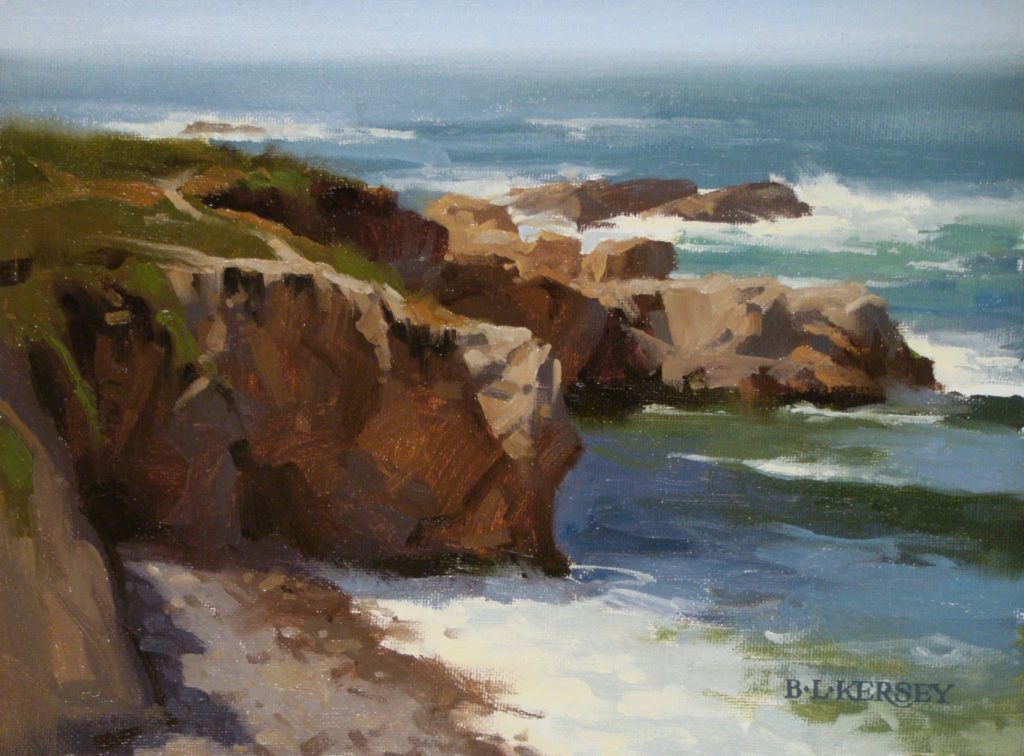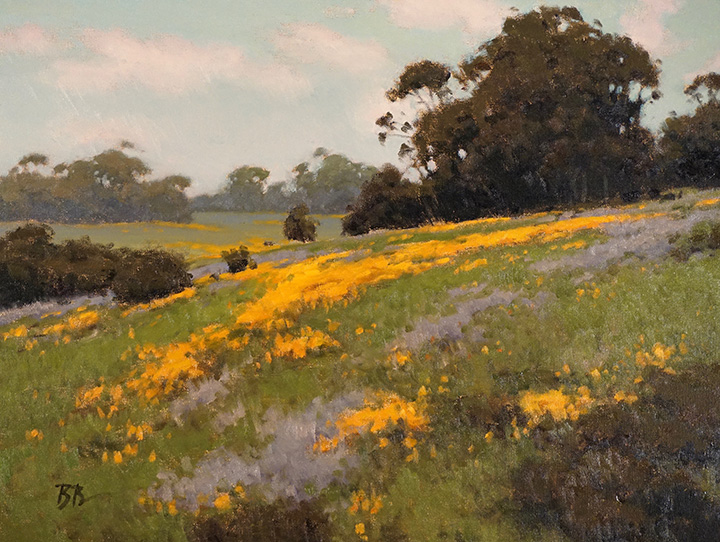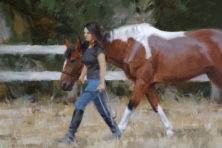Questions & Artists: Brian Blood and Laurie Kersey (Part II of II)
- Share
- Tweet
- Pin
- Share

Following is the final of a two-part interview with Brian Blood and Laurie Kersey, both wonderfully accomplished individuals who are invited artists in this year’s Door County Plein Air Festival.
To see more of their visually stunning work, visit brianblood.com and lauriekersey.com. Read part one of the interview here.
Randy Rasmussen (RR): Laurie, how would you describe your work?
Laurie Kersey (LK): I have used the term “painterly realism” in the past but I think I’ve loosened up some since then. I suppose what I do would fall under the general category of Impressionism but mostly I figure categorizing my work is up to the art critics and art historians.

“Windy Garrapata” by Laurie Kersey
RR: Brian, you describe your work as Contemporary Impressionism. What is your current palette and has it changed over the years?
Brian Blood (BB): My palette is titanium white, cad yellow light, cad yellow deep, cad scarlet, alizarin crimson, cobalt blue, ultramarine blue, cinnabar green, viridian, burnt sienna and burnt umber. This has been my main palette for many years. I will pull and add colors for specific needs as well as use limited palettes from time to time. I use the same basic palette in the studio that I use out in the field. I find myself shifting my palettes when I travel…. The key I believe is to be able to recognize the need to make or try a change if faced with it and make it work for that painting.
RR: Laurie, what is your current palette?
LK: I will preface by saying that my palette is not a static thing; it is ever evolving and colors sometimes come or go. I also may vary somewhat depending on whether I’m painting landscape, still life, or figure. That being said, my core palette is titanium white, cadmium yellow light, cadmium yellow deep, cadmium red deep, alizarin crimson, ultramarine deep, cobalt blue light, viridian, transparent oxide red, and raw umber. Figures may require yellow ochre, raw sienna, or ivory black. Florals may require more vibrant reds or violets – quinacridone rose, dioxazine purple.

“Spring Poppies” by Brian Blood
RR: Laurie, I enjoyed reading one of your bios where you described as a girl attending art shows with your artist mother. At age 13 you started exhibiting your work. When did you know you were going to be a working artist?
LK: I was torn for a while at a young age between art and music, but art prevailed and I never set foot in another direction. So I have pretty much always known that this was going to be my path. Music remains a hobby. I remember at age 11 having a “show” of my artwork in a showcase at my school, which was probably the first time I received attention and positive reinforcement for my work.
RR: Did you both receive encouragement from individuals other than family members to pursue art as a career?
LK: Well, the aforementioned exhibition of my work at school at age 11 was encouragement, I’m sure. I think my middle school art teacher put that together. And then in high school my art teacher took me to the supply closet one day and told me that I could come to the art room any time and help myself to anything in the supply closet. She gave me free reign to play with all of the supplies and so I experimented with everything they had! I don’t remember any serious art education from either of those public school teachers but they both did encourage me. My mother participated in local outdoor art fairs and I had been tagging along as a kid but at 13 I began to participate as well and display my drawings – charcoal, pen and ink, scratchboard – which I offered for sale for $10 or $20. The people who purchased those drawings were definitely encouraging my career path!

“Woman’s Work” by Laurie Kersey
RR: Brian, why should people paint plein air?
BB: Plein air painting is a way to maintain your skills. It’s all about observation. Training your eye to see. Seeing color harmonies, relationships between objects, designing and developing interesting compositions. Seeing the subtle color shifts in shadows or establishing reflective light. Painting outdoors is the way artists gather information to help guide them through the painting process. It also forces you to make decisions and to react to the ever-changing scenes of nature.
RR: Why is fine art still relevant?
LK: Art is uplifting. It should touch people on some level, not match their sofa! Whether it evokes a certain mood or reminds them of a particular place or time or makes them feel the sand between their toes or the sun on their face or recalls the scent of a rose or an ocean breeze…it should elicit a reaction on a subconscious, visceral level.
BB: If people didn’t buy art then I’d be homeless and that would really suck. But I think it important too because I see it as I’m preserving moments in time. Man goes around and tears down places and changes nature. At least if I’m making paintings of some of these lost areas then there’s a record of what used to be there.


